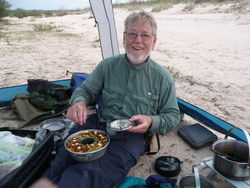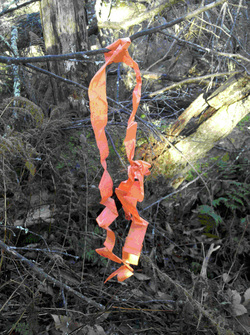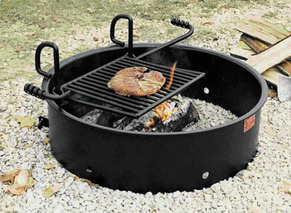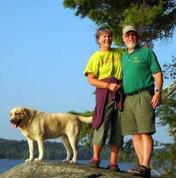
#46 - lessons learned leading 35 years of wilderness ventures - Don't Leave Stuff in the Outdoors12/23/2010 Here’s the fifth of fifty installments on “lessons learned leading 35 years of wilderness ventures.” Please feel free to leave a comment or better yet start a dialogue. First Time Readers of this Blog: Disclaimer – I don’t claim that these are necessarily profound or original. They are what came to mind when, in preparation for a presentation titled: “20 Years of Adirondack Wilderness Expeditions,” I scanned a couple of hundred 35mm slides of the trips I have led. It was only after I had provided the title and description of the presentation that I realized it was more like 35 years of leading Adirondack ventures and that I’m getting older than dirt. Backstory: A number of people have asked me if I have already determined the fifty lessons learned. The answer is yes. When I planned the presentation mentioned above I came up with the list and then when I decided to create these blog entries I put them in priority order from 50 to number 1. Why a countdown? A la David Letterman I thought it would be more interesting to go from what I consider the least profound “lesson learned” to my most profound. People have also asked me what number 1 is and I’ll tell you what I told them. You have to wait and see. I may tweak the list as I move forward but I expect it to remain substantially the same. #46 Don’t leave stuff in the outdoors. That includes, at campsites, lean tos, fire places or anywhere else. Some stuff, like trash, I just can’t understand finding in the outdoors. What are people thinking? Oh, that’s right, they aren’t thinking. Why does anyone intentionally litter? We have had anti-litter campaigns since the 1920s and evidently they have improved the look of the land considerably yet we still have yahoos who think nothing of tossing their beer can, sandwich bag, candy wrapper, cigarette butt, and anything else you can think of over their shoulder without looking back. While this litter drives me nuts and we all have to continue to try to educate via soft sell (tv, radio, poster & other media campaigns) and hard sell (law enforcement), this “lesson learned” is not so much about this kind of stuff in the outdoors as it is about the subtle stuff we leave behind. What do I mean? Let’s start with lean-tos my favorite symbol of a wilderness slum. First we frequently find food left behind. What could possibly be the reason for that? No one wants to eat the food you have left behind except perhaps mice, red squirrels, bears, other wild animals. How many times have you eaten food you have found in a lean-to? My guess is never. So, as the old saying goes, “If you pack it in, pack it out.” Don’t leave it behind thinking that you are doing somebody a favor. Good neighbors bring you food when you move in; they don’t leave it behind when they move away.  Lean to “left behinds” – 1984 Let’s move on to the fireplace you typically find at an established campsite. Let’s forget that it is probably crumbling apart and looks more like a micro-version of the Twin Towers after 9/11. (My understanding is that certain land managers won’t allow the nearly indestructible black metal fire rings to be used in most areas of the Park. I don’t understand that thinking. The lower maintenance and more attractive steel fire rings are much safer and easier on the environment than cement or rubble fireplaces, but that’s a topic for another day.) What do you find in the decaying fireplace? One or more of the following: logs too big to burn but just the right size to fit on the Axeman’s logging truck, enough aluminum foil (hot chocolate wrappers don’t burn, folks… they are made of aluminum foil) to roast a pig in, and assorted paper and cardboard wrappers and containers. You might even find a section of the New York Times. (That shouldn’t be a problem for too long given the plight of the newspaper industry.)  A lean to in the Dix Wilderness Area – 1983The pile of rocks in the foreground is the fireplace. Here are Jack’s “rules are for fools” rules regarding putting things into fireplaces. Put nothing into a fireplace…
 surveyor's tape tied to a branch Okay, what other subtle (or not so subtle) things do I find in the outdoors that I don’t think belong there. How about surveyor’s flagging? You know that mostly fluorescent orange but sometimes fluorescent green and occasionally electric blue plastic (yes, plastic and non-biodegradable) roll of tape that surveyors use to mark property lines? Of course I’m not talking about surveyors’ use of this stuff. I’m talking about the people who can’t find their way through the woods, won’t buy a GPS unit, or just don’t give a damn about leaving their little signs through the woods. So how are these little wilderness fluorescent gems used? Two general groups of recreational surveyor’s tape users exist as far as I can tell. One group is the peak baggers who pioneer (or at least think they pioneer) their way up a mountain and want to mark it for others or for their way back down the mountain. The other group is hunters who can’t find their way around the woods so like Hansel and Gretel left breadcrumbs to find their way home, hunters leave a surveyor’s tape trail to find their way out of the woods. In this era of sub-$100 GPS units there is no need for surveyor’s tape. Buy a GPS unit! For less than your monthly beer budget you can buy a unit that will take you anywhere on earth and help you find your way back again. Better yet, learn map and compass skills that negate the need for surveyor’s tape. I’ve hiked, paddled, hunted, and fished all over the world and have yet to need surveyor’s tape. There is no need for leaving surveyor’s tape, paint blazes or Hansel and Gretel’s bread crumbs.  When we talk about leaving stuff behind, I didn’t think I had to include canoes! 1979 You may ask, “What the hell’s the difference? Why do you even care?” To some extent if you ask the question then you probably don’t get the value of the wild outdoors. I know I risk sounding arrogant or elitist. Perhaps I am. What makes the wild outdoors different than regular rural outdoors? I would argue that the more natural an area is the more you can enjoy the sense of naturalness. (as opposed to unnaturalness i.e., signs of humans – I know, humans are part of the environment and are thus “natural” but for our purposes I would argue humans are the only animal that can manipulate the environment to such an extent that it no longer appears “natural.” Naturalness is a discussion beyond the scope of this blog entry.) The more natural the wild outdoors is the greater your “wilderness state of mind” is. Roderick Nash does a great job of talking about wilderness as a “state of mind” in his book, Wilderness and the American Mind . Suffice to say that how you feel about your sense of wildness really determines how wild it really is. In other words when I hunt in one area that has very few signs of humans I really get a great sense of wildness. Never mind that it is not officially a wilderness area. The point is that if you leave the litter, surveyor’s tape, and other human detritus at home, the wilder you will feel thus the wilder the land will be. If this makes no sense to you or you don’t buy it than it just means naturalness and wildness are not that important to you. Sorry, there I go sounding elitist again. Bottom Line:
To visit #45 Click Here (not active yet) Here's a great look at the issue of Physical Education requirements in public schools. How can anyone look at the obesity epidemic in our country and think physical education should be abolished?
http://blog.wholechildeducation.org/2010/12/21/pe-criticism-and-responses/ This is your new blog post. Click here and start typing, or drag in elements from the top bar.
I had a bit of fun using Google's new word search, Books Ngram Viewer, that lets users key in words or phrases and plot how their usage has evolved.You select a time period and the word or words and BINGO you get a graph of the word usage in books for that time period. I played around with some different outdoor recreation terms just for fun. Some of the results are listed below. Let me know if you come up with some interesting findings.
 Edutopia has a series of excellent articles on brain-based learning and what the latest science reveals. Check them out here. I know what you're thinking, what is it with this "brain-based learning"? Isn't all learning brain based. Yes all learning is indeed "brain based" and indeed there is a lot of misinformation about it out there. On the other hand we are learning so much about how the brain functions it is a travesty if teachers aren't keeping up with what we are learning about the brain and how humans learn. It would be like your car mechanic not learning the role computers play in diagnosing what is wrong with your car. Worse yet it is would be like you doctor not learning anything new once they got their diploma. All educators need to be keeping up with with what we know about how the brain learns. There are three articles. One is on what is considered the fact and fiction of brain-based learning. Read it here. The second is on the plasticity of the brain. Read it here. My favorite is the third one about the role of emotional safety and learning. It also provides the most hands on ideas of how to apply the concepts of brain-based learning in the classroom. You can read it here. This is your new blog post. Click here and start typing, or drag in elements from the top bar. |
Jack Drury's Leading E.D.G.E. Blog
Sharing Observations on Education, Wilderness, and About the AuthorThis blog was created and is maintained by Jack Drury with contributions from Bruce Bonney. Jack and Bruce have been working together since 1984 providing professional development in four areas: Categories
All
Leading E.D.G.E. is proud to be a founding partner of the Adirondack Forest Preserve Partnership 
Links:Archives
March 2015
|






 RSS Feed
RSS Feed
